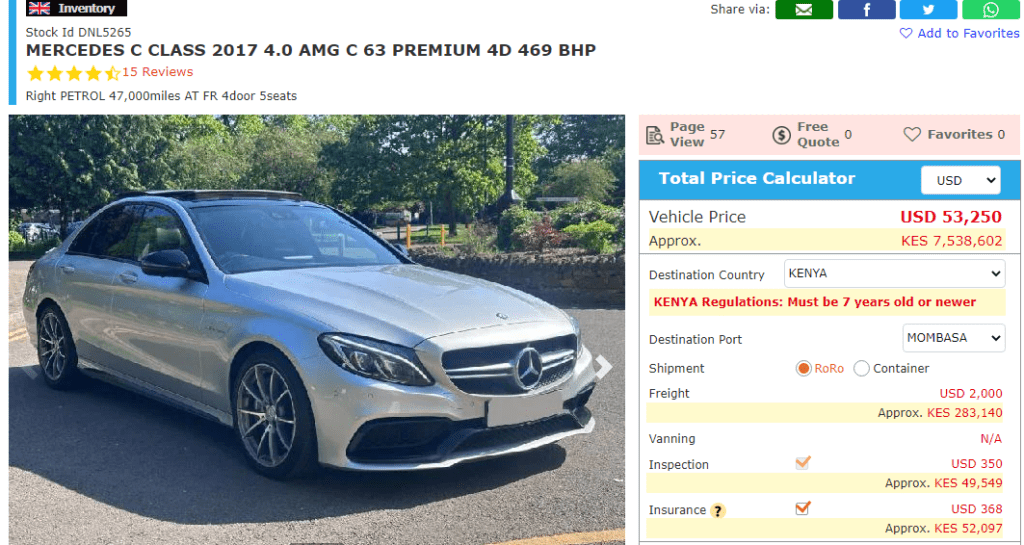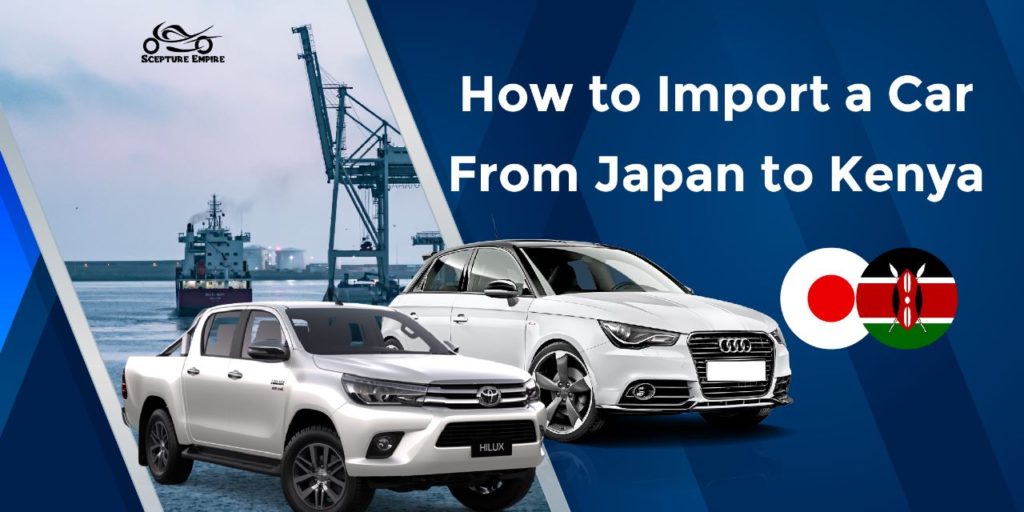Are you planning to import a car from Japan to Kenya? Below is the most comprehensive guide you will find on the internet on how to import a car from Japan to Kenya.
Buying a car from Japan can result in huge savings instead of buying one locally. However, if you’re not careful, you might lose your money or spend much more than you would have ordinarily spent if you bought a locally available car.
But the good news is, we’re here to give you all the information you need so that you can make all the right decisions throughout the process and hopefully save you some money on your intended purchase.
You Might Also Like Our Do-It-For-You Vehicle Importation Service
How to Import a Car From Japan to Kenya
The following are the 5 simple steps on how to import a car from Japan to Kenya. We have also complied a list of 11 cheap cars as well as some of the most fuel efficient cars that you might consider to import from Japan.
- Identify a vehicle exporter in Japan
- Start the importation process
- Documentation
- Custom clearance/Duty payment
- Collect your car from CFS and enjoy
Without further ado, let’s dive deep into the 5 steps
Table of Contents
Identify a Vehicle Exporter in Japan
The first step is to identify a vehicle exporter in Japan. They are quite a few but the most popular ones are SBT Japan and Be Forward Japan.
Search through their database and identify the type of vehicle you want. When searching for the type of vehicle you want there are 3 important things to keep in mind.
- You can only import a vehicle that’s not more than 8 years from the year of manufacture.
- The vehicle must be a right-hand drive vehicle (RHD).
- Get a high-grade car. Most cars in Japan go through an auction process, during the auction they’re graded from 1 to 6, 1 being the lowest grade and 6 being the highest. Therefore, you should ensure the grade is above 3.5 for a good car.
After you have settled on a vehicle that conforms to the above conditions you can then proceed to make an inquiry with the exporter, during the inquiry period you can negotiate the price listed on the vehicle and you might be lucky to get a discount if your negotiation skills are top notch.
But wait! There’s more, the prices listed on the Japan websites are CIF costs. CIF is the Cost, Insurance, and freight. This is basically the cost of the car plus marine insurance and the shipping cost to Mombasa.
CIF cost is not the final cost of the vehicle as it does not include taxes or import duty which is payable to the Kenya Revenue Authority once the vehicle arrives in Mombasa.

Start The Importation Process
After the CIF cost is agreed upon you will receive an invoice from the exporter in Japan you can then proceed to make the payment through any bank in Kenya.
Once the payment is received in Japan the car will be taken for inspection. All vehicles imported to Kenya should undergo inspection from the country of origin by an organization appointed by the Kenya Bureau of Standards. In this case, the appointed organization is called QISJ ( Quality Inspection Services Japan).
QISJ is required to inspect the vehicle and have the mileage and other conditions of the car in its database. Thereafter, they issue an inspection certificate.
Bonus Tip: As I said earlier QISJ records the mileage of the car during inspection you can therefore access their database and check what mileage was the car at before it was imported to Kenya. This is an advantage to local car buyers as some dealers do reverse the mileage to make the car look newer.
After inspection is done the car is now ready to leave Japan, most vehicles are shipped through RORO (Roll on/Roll Off) method but they can also be shipped in a container, however, the CIF cost will increase if shipment is to be done in a container.
Documentation
Congratulation, you’re now halfway to getting your car. But before that, there’s a series of documentation required in order to be able to clear the car from customs once it arrives in Mombasa.
The seller in Japan should provide you with the following documents before the car gets to Mombasa, they’re usually sent via DHL.
- The Bill of Landing
- Export certificate
- Inspection Certificate
The Bill of Landing
This is a legal document issued by a carrier to a shipper that details the type, quantity, and destination of the goods being carried.
It will therefore contain the vehicle details, the consignee, the shipper, and the notifying party.
Always make sure the consignee is yourself as these are the details that will be used to register the car once it gets to Kenya. The notifying party is the person that will receive these documents.
Export Certificate
The export certificate will also contain details of the car, the previous registered owner from the country of origin, what the vehicle was being used for, and whether the car has been deregistered from the Japan vehicle registration system.
Inspection Certificate
The inspection certificate will be issued by QISJ and it will indicate if the vehicle is roadworthy and safe, and whether it conforms to other requirements laid out by the Kenya Bureau of Standards.
Custom Clearance / Duty Payment
The last process of vehicle importation is having the vehicle cleared at customs once it gets to Mombasa port. When the car is offloaded from the ship it will be driven to a pre-determined CFS (Container freight station).
This is where it will be stored before duty is paid/cleared by customs. Ensure clearing is done within the shortest time possible to avoid incurring hefty CFS charges.
To be able to clear your vehicle at customs you will need the help of a KRA-registered customs agent. The agent will require the documents we talked about earlier as well as your national ID and KRA pin.
A few days before the car arrives in Mombasa the clearing agent will log in to the KRA system and submit an Import Declaration Form (IDF). These documents declare that a certain vehicle has been imported into the country. They are then able to generate an entry sheet that shows the amount of taxes to be paid to KRA.
You can then proceed to pay the taxes in any bank in Kenya or your clearing agent can pay on your behalf, as per your agreement.
Last but not least, you need to create a TIMS account with NTSA. The clearing agent will then access this account and apply for registration, after a successful registration your car details will appear on your account and NTSA will allocate a registration number for your car.
The agent will then collect the physical digital number plates on your behalf and fix them on the car.
YOU MIGHT ALSO LIKE: BEST CAR FOR UBER BUSINESS IN KENYA
Collect The Car & Enjoy
At this point, the car is ready for collection but there are a few other things you need to do.
- Get an insurance cover for the car. The law requires that before driving any car on Kenyan roads it needs to have an insurance cover, the minimum being a third-party cover. But it’s recommended to get a comprehensive cover as it covers the car in case of an accident.
- It’s also recommended to install a Car Tracker. That way you’re able to track the real-time location of the car anywhere and at any time.
You can now enjoy your vehicle with a big smile having saved a few hundred thousand. Do not forget to share this information with a friend so that they can benefit from the nuggets herein on how to import a car from Japan to Kenya.
Our Do-It-For-You Vehicle Importation Service
Import your dream car easily with our do-it-for-you car importation service.
Simply fill out the form below and Stankam Motors Ltd will do the rest. Let’s make your dream car a reality.
When filling out the contact form, please provide a phone number where you can be contacted. After submitting your request, one of Stankam Motors Ltd.'s sales representatives will reach out to you by phone and advise you on the next steps.

Kevin Muya is an award-winning entrepreneur and the visionary Founder and CEO of Scepture Empire Limited. With a passion for e-commerce and digital marketing, Kevin has revolutionized online marketplaces in Kenya through innovative ideas that transform buyer-seller interactions.

